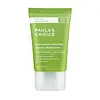What's inside
What's inside
 Key Ingredients
Key Ingredients

 Benefits
Benefits

 Concerns
Concerns

 Ingredients Side-by-side
Ingredients Side-by-side

Water
Skin ConditioningGlycerin
HumectantButylene Glycol
HumectantDimethicone
EmollientSodium Polyacrylate
AbsorbentCamellia Sinensis Leaf Extract
AntimicrobialIris Florentina Root Extract
MaskingMacadamia Ternifolia Seed Oil
EmollientEpigallocatechin Gallate
AntioxidantHydrogenated Polydecene
EmollientTrideceth-6
EmulsifyingSodium Hyaluronate
HumectantSqualane
EmollientCaprylic/Capric Triglyceride
MaskingEthylhexyl Palmitate
EmollientPPG-2 Myristyl Ether Propionate
EmollientAlcohol
AntimicrobialAllantoin
Skin ConditioningPropanediol
SolventC12-15 Alkyl Lactate
EmollientPolyquaternium-11
Disodium EDTA
Ethylparaben
PreservativeMethylparaben
PreservativePropylparaben
PreservativePhenoxyethanol
PreservativeParfum
MaskingWater, Glycerin, Butylene Glycol, Dimethicone, Sodium Polyacrylate, Camellia Sinensis Leaf Extract, Iris Florentina Root Extract, Macadamia Ternifolia Seed Oil, Epigallocatechin Gallate, Hydrogenated Polydecene, Trideceth-6, Sodium Hyaluronate, Squalane, Caprylic/Capric Triglyceride, Ethylhexyl Palmitate, PPG-2 Myristyl Ether Propionate, Alcohol, Allantoin, Propanediol, C12-15 Alkyl Lactate, Polyquaternium-11, Disodium EDTA, Ethylparaben, Methylparaben, Propylparaben, Phenoxyethanol, Parfum
Water
Skin ConditioningTheobroma Cacao Seed Butter
EmollientGlycerin
HumectantVitis Vinifera
MaskingCanola Oil
EmollientOlea Europaea Fruit Oil
MaskingButyrospermum Parkii Butter Unsaponifiables
Skin ConditioningBenzyl Alcohol
PerfumingPropanediol
SolventBorago Officinalis Seed Oil
EmollientOenothera Biennis Oil
EmollientSodium Hyaluronate
HumectantRubus Idaeus Fruit Extract
AstringentVaccinium Macrocarpon Fruit Extract
AstringentVaccinium Myrtillus Fruit Extract
Skin ConditioningMalpighia Emarginata Fruit Extract
Skin ConditioningLycium Barbarum Fruit Extract
AstringentAloe Ferox Leaf Juice Extract
Skin ConditioningTocopherol
AntioxidantHydrogenated Lecithin
EmulsifyingThermus Thermophillus Ferment
Skin ConditioningRosa Canina Callus Lysate
AntioxidantLinum Usitatissimum Seed Oil
PerfumingCaprylic/Capric Triglyceride
MaskingArginine
MaskingGlycine
BufferingAlanine
MaskingSerine
MaskingValine
MaskingProline
Skin ConditioningThreonine
Isoleucine
Skin ConditioningHistidine
HumectantPhenylalanine
MaskingAspartic Acid
MaskingHelianthus Annuus Seed Oil
EmollientCarrageenan
Sodium Lactate
BufferingPotassium PCA
HumectantSodium PCA
HumectantSilica
AbrasiveXanthan Gum
EmulsifyingLeuconostoc/Radish Root Ferment Filtrate
AntimicrobialCaprylyl Glycol
EmollientGlyceryl Stearate
EmollientPCA
HumectantPhenoxyethanol
PreservativePotassium Sorbate
PreservativeSodium Benzoate
MaskingWater, Theobroma Cacao Seed Butter, Glycerin, Vitis Vinifera, Canola Oil, Olea Europaea Fruit Oil, Butyrospermum Parkii Butter Unsaponifiables, Benzyl Alcohol, Propanediol, Borago Officinalis Seed Oil, Oenothera Biennis Oil, Sodium Hyaluronate, Rubus Idaeus Fruit Extract, Vaccinium Macrocarpon Fruit Extract, Vaccinium Myrtillus Fruit Extract, Malpighia Emarginata Fruit Extract, Lycium Barbarum Fruit Extract, Aloe Ferox Leaf Juice Extract, Tocopherol, Hydrogenated Lecithin, Thermus Thermophillus Ferment, Rosa Canina Callus Lysate, Linum Usitatissimum Seed Oil, Caprylic/Capric Triglyceride, Arginine, Glycine, Alanine, Serine, Valine, Proline, Threonine, Isoleucine, Histidine, Phenylalanine, Aspartic Acid, Helianthus Annuus Seed Oil, Carrageenan, Sodium Lactate, Potassium PCA, Sodium PCA, Silica, Xanthan Gum, Leuconostoc/Radish Root Ferment Filtrate, Caprylyl Glycol, Glyceryl Stearate, PCA, Phenoxyethanol, Potassium Sorbate, Sodium Benzoate
Ingredients Explained
These ingredients are found in both products.
Ingredients higher up in an ingredient list are typically present in a larger amount.
This ingredient is an emollient, solvent, and texture enhancer. It is considered a skin-softener by helping the skin prevent moisture loss.
It helps thicken a product's formula and makes it easier to spread by dissolving clumping compounds.
Caprylic Triglyceride is made by combining glycerin with coconut oil, forming a clear liquid.
While there is an assumption Caprylic Triglyceride can clog pores due to it being derived from coconut oil, there is no research supporting this.
Learn more about Caprylic/Capric TriglycerideGlycerin is already naturally found in your skin. It helps moisturize and protect your skin.
A study from 2016 found glycerin to be more effective as a humectant than AHAs and hyaluronic acid.
As a humectant, it helps the skin stay hydrated by pulling moisture to your skin. The low molecular weight of glycerin allows it to pull moisture into the deeper layers of your skin.
Hydrated skin improves your skin barrier; Your skin barrier helps protect against irritants and bacteria.
Glycerin has also been found to have antimicrobial and antiviral properties. Due to these properties, glycerin is often used in wound and burn treatments.
In cosmetics, glycerin is usually derived from plants such as soybean or palm. However, it can also be sourced from animals, such as tallow or animal fat.
This ingredient is organic, colorless, odorless, and non-toxic.
Glycerin is the name for this ingredient in American English. British English uses Glycerol/Glycerine.
Learn more about GlycerinPhenoxyethanol is a preservative that has germicide, antimicrobial, and aromatic properties. Studies show that phenoxyethanol can prevent microbial growth. By itself, it has a scent that is similar to that of a rose.
It's often used in formulations along with Caprylyl Glycol to preserve the shelf life of products.
Propanediol is an all-star ingredient. It softens, hydrates, and smooths the skin.
It’s often used to:
Propanediol is not likely to cause sensitivity and considered safe to use. It is derived from corn or petroleum with a clear color and no scent.
Learn more about PropanediolSodium Hyaluronate is hyaluronic acid's salt form. It is commonly derived from the sodium salt of hyaluronic acid.
Like hyaluronic acid, it is great at holding water and acts as a humectant. This makes it a great skin hydrating ingredient.
Sodium Hyaluronate is naturally occurring in our bodies and is mostly found in eye fluid and joints.
These are some other common types of Hyaluronic Acid:
Learn more about Sodium HyaluronateWater. It's the most common cosmetic ingredient of all. You'll usually see it at the top of ingredient lists, meaning that it makes up the largest part of the product.
So why is it so popular? Water most often acts as a solvent - this means that it helps dissolve other ingredients into the formulation.
You'll also recognize water as that liquid we all need to stay alive. If you see this, drink a glass of water. Stay hydrated!
Learn more about Water